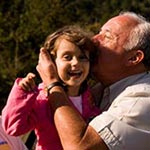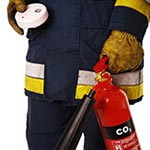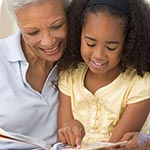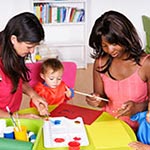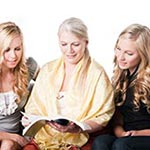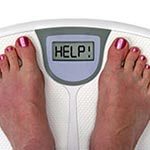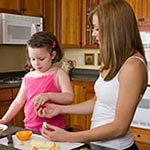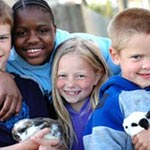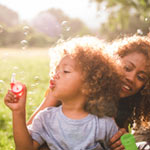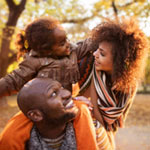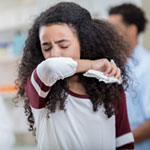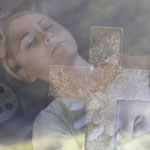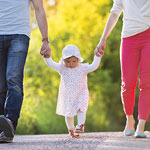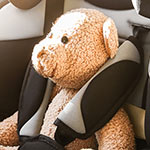Top Ten Child Safety Issues

Globe Life and Accident Insurance Company is a leading provider of children’s life insurance. Since it is our business to help protect your family’s well being, we are providing updated information on the top ten child safety issues:
- Child Safety Seats
- School Bus Safety
- Helmets
- Amusement Parks and Carnivals
- Playground Hazards
- Household Hazards
- Guns
- Safe Eating
- Safe Sleeping
- Stranger Warnings
Child Safety Seats
Accidents usually happen without a lot of warning. Even routine trips can expose our children to danger from motor vehicles. In fact, collision-related injuries to passengers have been cited as the leading cause of death for children under age 14.1

A great deal of evidence shows that when properly used, child safety seats and safety belts can save lives.3 In fact, studies have shown that during a collision, these seats reduce the risk of death by 71% for infants and 54% for toddlers.4
Children must be restrained in seats that are in accordance with their size and age. There are three basic types, which are designed to accommodate children of different ages and weights.
Convertible Infant Seats are used for newborn babies. At first, the seats should be positioned to face the rear of the car. These types of infant seats are considered convertible because they can be turned to face the front of the car when the child weighs over 20 pounds. They also come equipped with a safety belt and harness that must be completely secured. The child can continue using this type of seat until he/she weighs 40 pounds.
Booster seats are for school-age children who have outgrown convertible infant seats. This type of seat is used until the child becomes 8 years old or when he/she grows to a height of 4 feet 9 inches.5
For maximum protection during a collision, children should be restricted from riding in the front seat of passenger vehicles until they are 13 years old.6
School Bus Safety
Passenger cars are not the only vehicles that expose children to danger on the road. More than 22 million students, nationwide, ride on school buses. However, statistics from the National Highway Traffic Safety Administration’s Fatality Analysis Reporting System (FARS) and General Estimates System (GES) show that most children injured by school buses are not even riding inside them! Instead, children suffer injuries when boarding or exiting the bus because they are in places that are not visible to the driver.
The National Safety Council advises teaching children to learn and practice the following school bus safety rules:
- Stay away from the bus’ rear wheels at all times. (Stay away from traffic and do not run around or shove each other.)
- When waiting for the school bus, stay back and away from the street until the bus comes to a complete stop, and the rear door opens. (The child should stand on the same side of the street as the bus stop.)
- Hold the handrail while going up or down the steps. (Children should get in line away from the street. Younger students should stand in front of the line.) All of the students should board single file.
- When on the bus, go directly to a seat. Do not stand up in a moving bus. (Explain that loud talking and goofing around can distract the driver).
- Never stick hands, arms, or head out of the window, and never throw things out of the windows or on the bus.
- Keep aisles clear. Book bags should be kept on laps. (They can block the path in an emergency).
- When exiting, always cross the street in front of the bus. (Explain they should not cross the centerline of the road until the driver signals that it is safe).7
Helmets
Motor vehicle accidents are only one hazard to children. Parents should teach children to wear a helmet every time they ride their bikes, use skateboards, ride scooters, or go skating. Their helmet should be constructed with thick shock-absorbing material. Additionally, it should be positioned low on the forehead, not tilted back.
Purchase a new helmet after the old one has protected a child from being injured. The impact of a fall can cause a helmet to lose its protective qualities. It is also important to make sure your child knows how to buckle the helmet, quickly and easily.9
A summer fun activity such as bike riding is considered dangerous unless the proper safety gear is worn.
Amusement Parks and Carnivals
Other summer fun activities include trying out all the newest exciting rides at amusement parks and carnivals. Most of the children who wind up getting treated in emergency rooms are there because the parents incorrectly assumed a ride was appropriate for their child. The National Safe Kids Campaign press release advises parents to remember that height guidelines are not always reliable. Instead, parents must appraise the ability of their child to obey ride instructions. For example, Alan Korn, Director of Public Policy, and General Counsel for Safe Kids USA advises parents to reinforce the authority of the ride operator. “If the ride operator tells children to keep their hands and feet inside the car or to hold the handrail, explain to your children that there is a good reason for the rule.” Officials estimate that 8,000 children, ages 14 and under become injured because of using poor judgment or behaving improperly on the rides.10
Playground Hazards
Summer fun can also be dangerous when children spend time at playgrounds. Similar to amusement park rides, parents and caregivers should make sure playground equipment is appropriate for the child’s age. The newest advice involves making sure children are being supervised by adults.
Each year more than 200,000 preschool and elementary school age children are injured from falling while using playground equipment.11 When their imaginations run wild, children sometimes believe they have superpowers that enable them to do remarkable physical feats on the playground equipment. This puts children at risk of becoming seriously injured.12
Most playground injuries are related to the climbing equipment, such as monkey bars. “Researchers identified 204 children ages 20 months to 12 years who were injured.”13 In fact, the amount of injuries that result from children playing on monkey bars is significant enough that many experts want them removed from playgrounds.14 Meanwhile, in case of falls, parents can make sure that the playground surface is loosely filled with wood chips, mulch, sand, gravel, shredded rubber, or rubber like surfacing materials.15/16
Household Hazards
Babies seem to practice their future playground skills when they first learn how to climb on furniture. This is when medicine cabinets become attractive goals for a baby to conquer. It is necessary to remove all items that present a danger to children. Keep all household chemicals and pharmaceuticals out of their reach. In addition, remove access to cleaning products that are typically stored under the sink. As a precaution, write down the phone number for the poison control center, which is 1-800-222-1222. Keep this number on or near every phone in your home.17
Guns
If you own a gun, keep it locked, unloaded, and out of reach of children. However, even if your child does not have access to a gun in your home, he or she may be shown a gun when visiting another child. In fact, guns are in more than one third of all U.S. households.
The National Rifle Association (NRA) advises parents to teach children that if a friend shows them a gun, they should not touch it. Instead, explain that children should immediately leave the vicinity and tell an adult.18
Safe Eating
Of course, playing with guns represents a potential danger for young children, but simply eating food can also be considered dangerous. The most recent statistics show that choking is the leading cause of death in children under 5 years old. As children gain the ability to feed themselves, they often attempt to put inappropriate or large objects into their mouths. Martin Stutsman, a consumer safety officer in the Food and Drug Administration’s Center for Food Safety and Applied Nutrition pointed out the obvious necessity of teaching children “safe eating”. This expert cautions parents to make sure children carefully chew their food before they swallow it, and to teach children that food is the only object that belongs in their mouths. Any object can become lodged in a child’s airway. If the food or other object prevents oxygen from getting to the lungs and brain for more than four minutes, the result could be brain damage or death. As a safety precaution, round for firm such as sliced carrots or grapes should be cut or diced into small particles.19
If a child begins to choke on an object, the best way to help is by knowing how to administer Cardio Pulmonary Resuscitation, (CPR). When performed correctly and as quickly as possible, CPR can save a child’s life by restoring breathing and circulation. In effect, the rescuer will be breathing for the victim by forcing air into the lungs. A CPR course will teach the correct way that rescuers should position themselves and the correct intervals for breathing into the victim’s mouth. Knowing how to correctly administer CPR can also prepare parents and caregivers for other types of emergencies that may require rescue breathing.20
Safe Sleeping
Sudden Infant Death Syndrome (SIDS), otherwise known as “crib death” is blamed when a baby dies from unknown causes. Before 1992, parents were being advised not to place babies on their backs when putting them to sleep. It was assumed that babies were more likely to choke if they were lying on their backs. However, in 1992, researchers found that babies who slept on their stomachs were at a greater risk of death than babies who slept on their backs. When The American Academy of Pediatrics began informing families to put babies to sleep on their backs, SIDS deaths were reduced by 50 percent in the United States. When parents learn the best way to reduce the chances of SIDS is putting their baby to sleep on his/her back, they may feel reassured.21
Stranger Warnings
Regrettably, the traditional child safety message taught by parents and schools of avoiding strangers may not be enough to adequately educate your children on how to best protect themselves from danger.
While ingraining the slogan “stranger danger” can help to instill prudence when encountering unfamiliar persons, the concepts of what defines a stranger and what real threats exist have shown to be difficult for children to fully grasp. In addition, it seems that in more incidences than not, the perpetrators are not strangers at all, but rather people they know that are often the victimizers.
Concerned parents should frequently sit down to candidly discuss with their children the real dangers that exist, to listen to their children’s experiences and concerns, and to reinforce the training needed to protect themselves from abduction and/or abuse. As a good rule of thumb, always require your child to check with a parent, a clearly defined caregiver, or a trusted teacher before conversing with adults, going anywhere, accepting anything, or getting into a car with anyone who is not an approved authority. In addition, always teach children the importance of saying “no” and immediately reporting to an authority anyone who does or says something that makes him/her feel uncomfortable, scared, or confused. Explain that they are not being tattle tales by talking with you about such concerns by reassuring them of the importance and significance that this type of open discussion has in the protection of themselves and their friends from danger.
The Most Obvious Protection
Globe Life and Accident Insurance Company recognizes the importance of keeping parents current about the latest safety information. Obviously, most parents and caregivers understand that discretionary caution is the best preventive strategy for keeping injuries at bay. However, properly safeguarding children by being prepared for unexpected emergencies is just as necessary.
1 CT Safe Kids-Keeping Your Grandchildren Safe & Sound. http://www.ctsafekids.com/Fact_Sheets/facat7.htm
2 Consumer Product Safety Commission. http://www.cpsc.gov/repscpub/pubs/5036.html
3 See CT Safe Kids-Keeping Your Grandchildren Safe & Sound.
4 IBID
5 IBID
6 American Academy of Pediatrics /Car Safety Seats: A guide for families. http://www.aap.org/family/Carseatguide.htm
7 National Safety Council School Bus Rules. http://www.nsc.org/resources/Factsheets/schoolbus/safety.aspx.
9 Golisano Children’s Hospital at Strong-University of Rochester Medical Center-Keeping Kids Safe-Bicycle Safety. http://www.stronghealth.com/services/childrens/safety/bike.cfm.
10 Safe Kids USA: Preventing accidental injury. Press Releases, Amusement Park Safety. http://www.usa.safekids.org/tier3_cd.cfm?content_item_id=25931&folder_id=300
11 Research Injuries. http://www.playgroundsafety.org/research/index.htm
12 Supervise Your Children While at the Playground–Your Orthopaedic Connection: Playground Safety. http://www.rthoinfo.aaos.org/topic.cfm?topic=A00131&return_link=0
13 See Supervise Your Children While at the Playground.
14 AAP News: Monkey bar injuries are often serious–American Academy of Pediatrics. http://aapnews.aappublications.org/cgi/content/abstract/15/7/2
15 National Safety Council. http://www.nsc.org/resources/factsheets/hl/playground_safety.aspx
16 Playground Safety-Kids Health. http://kidshealth.org/parent/fitness/safety/playground.html
17 CDC-Family Health–Parents: ABCs of Raising Safe and Healthy Kids. http://www.cdc.gov/family/parentabc/index.htm
18 Gun Safety. http://kidshealth.org/parent/firstaidsafe/home/gun_safety.html
19 Prevent Your Child From Choking-U.S. Food and Drug Administration. www.fda.gov/fdac/features/2005/505_choking.html
20 Emergencies-Kids Health. http://kidshealth.org/parent/firstaid_safe/emergencies/cpr.html
21 Safe Sleep for my Grandbaby. http://www.firstcandle.org/FC/PD3/safe%20sleep%20for%my%grandbaby.pdf
You might also be interested in...
-
 6 Tips For Choosing Childcare
6 Tips For Choosing Childcare
-
 Babysitting your new grandchild requires learning
Babysitting your new grandchild requires learning
-
 Building Your Kids Self Esteem
Building Your Kids Self Esteem
-
 Dangers Within Your Home
Dangers Within Your Home
-
 Fire Prevention Measures Every Parent Should Be Taking
Fire Prevention Measures Every Parent Should Be Taking
-
 Five Money Saving DIY Projects for Moms
Five Money Saving DIY Projects for Moms
-
 Five Tips to Help Your Child Develop Good Study Habits
Five Tips to Help Your Child Develop Good Study Habits
-
 Grandparents Raising Grandchildren
Grandparents Raising Grandchildren
-
 Helping Your Kids Make Healthier Food Choices
Helping Your Kids Make Healthier Food Choices
-
 How Homeschooling Can Be A Great Choice For Your Family
How Homeschooling Can Be A Great Choice For Your Family
-
 How Important is Reading with your Grandchildren?
How Important is Reading with your Grandchildren?
-
 How Life Insurance Can Benefit Your Children And Grandchildren
How Life Insurance Can Benefit Your Children And Grandchildren
-
 How to Choose a Safe Daycare for Your Child
How to Choose a Safe Daycare for Your Child
-
 How to Handle Public Temper Tantrums
How to Handle Public Temper Tantrums
-
 How to Leave Tangible Memories for Your Children and Grandchildren
How to Leave Tangible Memories for Your Children and Grandchildren
-
 How to Lose Weight after Having a Baby
How to Lose Weight after Having a Baby
-
 Quick and Easy Breakfasts for Kids on School Mornings
Quick and Easy Breakfasts for Kids on School Mornings
-
 Time Saving Tips for Stay At Home Moms
Time Saving Tips for Stay At Home Moms
-
 Tips to Help Your Child Perform Better At School
Tips to Help Your Child Perform Better At School
-
 Top Ten Child Safety Issues
Top Ten Child Safety Issues
-
 What Kind Of Leader Will Your Child Become?
What Kind Of Leader Will Your Child Become?
-
 Top 10 Fun Games To Play With Grandparents
Top 10 Fun Games To Play With Grandparents
-
 Is The Fear Of Missing Out Causing Your Teen To Lose Sleep
Is The Fear Of Missing Out Causing Your Teen To Lose Sleep
-
 5 Creative Activities For Parents & Kids
5 Creative Activities For Parents & Kids
-
 Is Your Child Safe Going To School
Is Your Child Safe Going To School
-
 4 Kid-Friendly Ways To Stay Active
4 Kid-Friendly Ways To Stay Active
-
 Avoiding the Summer “Brain Drain”
Avoiding the Summer “Brain Drain”
-
 8 Digital Skills Every Child Should Know
8 Digital Skills Every Child Should Know
-
 Fun Fall Activities To Do With Kids
Fun Fall Activities To Do With Kids
-
 Top 6 School Year Illnesses
Top 6 School Year Illnesses
-
 How To Save On Your Monthly Cable Bill
How To Save On Your Monthly Cable Bill
-
 Buying Life Insurance for Children
Buying Life Insurance for Children
-
 What Are the Odds of Dying Young?
What Are the Odds of Dying Young?
-
 Pros and Cons of Purchasing Life Insurance for Your Grandchildren
Pros and Cons of Purchasing Life Insurance for Your Grandchildren
-
 Can Both Parents Have Life Insurance on a Child?
Can Both Parents Have Life Insurance on a Child?
-
 Car Seat Danger: 5 Ways to Keep Young Children Safe in the Car
Car Seat Danger: 5 Ways to Keep Young Children Safe in the Car

 Insurance products are available in New York from
Insurance products are available in New York from  Insurance products are available in your state from
Insurance products are available in your state from 






